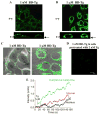Relocalization of STIM1 for activation of store-operated Ca(2+) entry is determined by the depletion of subplasma membrane endoplasmic reticulum Ca(2+) store
- PMID: 17298947
- PMCID: PMC3309416
- DOI: 10.1074/jbc.M609435200
Relocalization of STIM1 for activation of store-operated Ca(2+) entry is determined by the depletion of subplasma membrane endoplasmic reticulum Ca(2+) store
Abstract
STIM1 (stromal interacting molecule 1), an endoplasmic reticulum (ER) protein that controls store-operated Ca(2+) entry (SOCE), redistributes into punctae at the cell periphery after store depletion. This redistribution is suggested to have a causal role in activation of SOCE. However, whether peripheral STIM1 punctae that are involved in regulation of SOCE are determined by depletion of peripheral or more internal ER has not yet been demonstrated. Here we show that Ca(2+) depletion in subplasma membrane ER is sufficient for peripheral redistribution of STIM1 and activation of SOCE. 1 microM thapsigargin (Tg) induced substantial depletion of intracellular Ca(2+) stores and rapidly activated SOCE. In comparison, 1 nM Tg induced slower, about 60-70% less Ca(2+) depletion but similar SOCE. SOCE was confirmed by measuring I(SOC) in addition to Ca(2+), Mn(2+), and Ba(2+) entry. Importantly, 1 nM Tg caused redistribution of STIM1 only in the ER-plasma membrane junction, whereas 1 microM Tg caused a relatively global relocalization of STIM1 in the cell. During the time taken for STIM1 relocalization and SOCE activation, 1 nM Bodipy-fluorescein Tg primarily labeled the subplasma membrane region, whereas 1 microM Tg labeled the entire cell. The localization of Tg in the subplasma membrane region was associated with depletion of ER in this region and activation of SOCE. Together, these data suggest that peripheral STIM1 relocalization that is causal in regulation of SOCE is determined by the status of [Ca(2+)] in the ER in close proximity to the plasma membrane. Thus, the mechanism involved in regulation of SOCE is contained within the ER-plasma membrane junctional region.
Figures







Similar articles
-
Lipid rafts determine clustering of STIM1 in endoplasmic reticulum-plasma membrane junctions and regulation of store-operated Ca2+ entry (SOCE).J Biol Chem. 2008 Jun 20;283(25):17333-40. doi: 10.1074/jbc.M800107200. Epub 2008 Apr 22. J Biol Chem. 2008. PMID: 18430726 Free PMC article.
-
Intracellular Ca(2+) release via the ER translocon activates store-operated calcium entry.Pflugers Arch. 2007 Mar;453(6):797-808. doi: 10.1007/s00424-006-0163-5. Epub 2006 Dec 14. Pflugers Arch. 2007. PMID: 17171366
-
Ca2+ store depletion causes STIM1 to accumulate in ER regions closely associated with the plasma membrane.J Cell Biol. 2006 Sep 11;174(6):803-13. doi: 10.1083/jcb.200604014. J Cell Biol. 2006. PMID: 16966422 Free PMC article.
-
Key components of store-operated Ca2+ entry in non-excitable cells.J Pharmacol Sci. 2014;125(4):340-6. doi: 10.1254/jphs.14r06cp. Epub 2014 Jul 17. J Pharmacol Sci. 2014. PMID: 25030742 Review.
-
What role for store-operated Ca²⁺ entry in muscle?Microcirculation. 2013 May;20(4):330-6. doi: 10.1111/micc.12042. Microcirculation. 2013. PMID: 23312019 Free PMC article. Review.
Cited by
-
Plasma membrane-associated annexin A6 reduces Ca2+ entry by stabilizing the cortical actin cytoskeleton.J Biol Chem. 2009 Jun 19;284(25):17227-17242. doi: 10.1074/jbc.M109.004457. Epub 2009 Apr 22. J Biol Chem. 2009. PMID: 19386597 Free PMC article.
-
The Drosophila STIM1 orthologue, dSTIM, has roles in cell fate specification and tissue patterning.BMC Dev Biol. 2008 Oct 24;8:104. doi: 10.1186/1471-213X-8-104. BMC Dev Biol. 2008. PMID: 18950512 Free PMC article.
-
Regulation of cellular communication by signaling microdomains in the blood vessel wall.Pharmacol Rev. 2014 Mar 26;66(2):513-69. doi: 10.1124/pr.112.007351. Print 2014. Pharmacol Rev. 2014. PMID: 24671377 Free PMC article. Review.
-
STIM2 enhances receptor-stimulated Ca²⁺ signaling by promoting recruitment of STIM1 to the endoplasmic reticulum-plasma membrane junctions.Sci Signal. 2015 Jan 13;8(359):ra3. doi: 10.1126/scisignal.2005748. Sci Signal. 2015. PMID: 25587190 Free PMC article.
-
Organization and function of TRPC channelosomes.Pflugers Arch. 2007 Nov;455(2):187-200. doi: 10.1007/s00424-007-0252-0. Epub 2007 May 8. Pflugers Arch. 2007. PMID: 17486362 Review.
References
MeSH terms
Substances
Grants and funding
LinkOut - more resources
Full Text Sources
Other Literature Sources
Molecular Biology Databases
Miscellaneous

